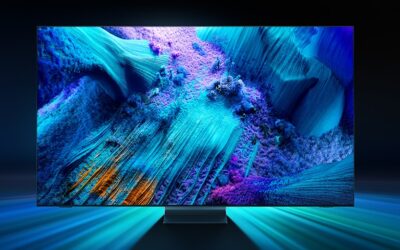The next IT superpower will be the one who has revolutionary networking technology. Here’s why we think that entity could be HP.
— Brian Pereira
Disclaimer: HP is not secretly collaborating with nuclear scientists in rogue nations to build a cache of nuclear weapons.
In the world of IT, no other area has seen such rapid progress as compute power. Thanks to Moore’s law, computing speed and power has been doubling every 18 months. However, other aspects of computing, such as storage or networking, haven’t kept up. Take operating systems, for instance. There have been several iterations of operating systems, but if you look closely, you won’t see any real breakthroughs in terms of a core OS technology. VAX, Open VMS, Unix and Tandem Nonstop were the last great OSes. Everyone else borrowed from them. And while bandwidth requirements are ever changing, we haven’t seen a radical leap in networking technology since Ethernet was invented. With mobiles phones, tablets, sensors, cars, refrigerator, TVs, wearables and everything with a chip inside it being connected to the Internet these days, there is a dire need for a new network operating system and networking technology that supports all these devices. That’s why we think the next big tech leap will happen in networking. And understandably, the next technology “superpower” will be the one who has revolutionary networking technology. We think that company could be HP.
The N-arsenal that HP has built over the years, organically or inorganically, comprises a veritable stock of alphabets – EVI, IRF, IMC, TRILL – and innovative technologies, architecture and frameworks — Flex Fabric, Flex Network Architecture, ClearPass, Virtual Connect, Web OS, and Converged Campus. At the hardware layer, HP has a stockpile of mean “big iron” systems such as Superdome, Moonshot and the 3PAR storage arrays.
If you stay with us till the end of this story, we promise to explain all this in very lucid terms.
So here’s why we think HP will dominate the world, of IT, that is.
Weapon #1: The Fabric
 Not long ago, we thought of Fabric as a piece of cloth with woven fibres. Well, it now has another meaning for us. Fabric (also called Switched Fabric or Switching Fabric) is defined as a network topology (arrangement/organization of all devices on a network), in which devices pass data to each other through interconnected switches. The mesh of interconnections can boost the transfer of data and workloads between network nodes.
Not long ago, we thought of Fabric as a piece of cloth with woven fibres. Well, it now has another meaning for us. Fabric (also called Switched Fabric or Switching Fabric) is defined as a network topology (arrangement/organization of all devices on a network), in which devices pass data to each other through interconnected switches. The mesh of interconnections can boost the transfer of data and workloads between network nodes.
HP claims to be the first to create a network Fabric. But this was done through its acquisition of Tandem Computers and its Nonstop S-series servers – way back in 1999. The heart of that system was a fabric called ServerNet; each ServerNet has its own file system and routing tables. The salient features of ServerNet were good scalability, clean fault containment, error detection and failover.
The fabric was the core in the S-series system. Even the CPU became a peripheral to the fabric! Ditto for other subsystems like the memory, storage and the I/O cards.
The fabrics were interconnected to create an expansive mesh. That enabled anyone to share data or communicate with anyone else on another system on the mesh. And location or distances did not matter as the fabrics were interconnected through fat pipes (high bandwidth or high speed connections). Which means parts of the system could reside in different cities, countries or even in different continents — and yet be viewed as one logical system. So this was a great example of distributed computing in the days when the Internet was yet to become widespread! Companies relied on VSATs and leased lines for WAN connectivity.
All the payment networks, banking institutions and some stock exchanges in India have their IT infrastructure based on the ServerNet fabric. The payment networks (credit card networks, for instance) are highly dependent on the fabric, because latencies of even a few milliseconds are unacceptable.
In 2005, HP introduced the fabric into world of Unix, and launched its Superdome systems with crossbar switching – a collection of switches arranged in a matrix configuration. This fabric introduced a balanced environment between transaction processing, query handling and batch processing. Earlier, a server was good at doing either one of these.
The other important feature of the fabric was that it could change the bandwidth of the system on its own.
This fabric empowered the HP Superdomes and they soon became a backbone for large ERP systems and core banking applications. And then Unix systems sounded the death knell for erstwhile mainframe systems, because they were more efficient in terms of processing capability and TCO (Total Cost of Ownership). And this was enabled by the fabric.
Intel x86 architecture has always been a standard for systems in the industry. But at one point, the industry realized that x86 had some limitations, and then decided to embrace other compute architectures (such as IA-64). The problem was latency in moving data and workloads between systems. That’s because all this had to move up north in the network topology and get to a switch – and then move down to the destination system. This is called North-South movement of network traffic.
But HP did something revolutionary in 2009. It launched Virtual Connect and FlexFabric for x86 systems, notably blade servers. This was regarded as a game changing move, and high performance computing shifted back to the x86 systems, which were by now highly commoditised and the industry standard. Again, it was the fabric that eliminated the limitations of x86 systems.
The mesh of interconnects between all the switches, enabled by the fabric, meant that the network traffic could now move East to West with minimal latency. Remember the aforementioned explanation of North-South movement?
The East-West movement of traffic between systems brought in huge efficiency and huge scale.
So you could build a highly robust system on x86 because of the fabric.
“The largest networking company was upset and asked us why we did this (Fabric on x86). It impacted their business”
–Santanu Ghose, Director – HP Networking Enterprise Group
“FlexFabric and Virtual Connect created a very large impact on the industry. It eliminated 66 percent edge switches, 72 percent NIC devices, and 90 percent cabling for any organization that adopted it,” claims Santanu Ghose, Director – HP Networking Enterprise Group. “The largest networking company was upset and asked us why we did this. It impacted their business. Ironically, HP was the key system integrator for that company at that time. HP said technology doesn’t stand still – if we don’t do this, somebody else will.”
Ghose claims that HP has shipped 5 times more Virtual Connect ports than the largest network company.
In computer networking, the term port can refer to either physical or virtual connection points for the network nodes/devices. Physical network ports allow connecting cables to computers, routers, modems and other peripheral devices (for instance Ethernet ports).
The industry benchmarks leadership in the network space based on the number of ports sold by a company, in terms of its networking equipment.
What next?
“We felt the work that we did with fabrics had to be extended to people, as user bandwidth demands are rapidly increasing,” said Ghose.
In Part 2 of this story we learn about HP’s other N-weapons: IRF, TRILL, and SDN — and how these are solving the bandwidth problem for users. Read it here.
————————————————————————————————————————————–
The writer was invited to HP Network University at IIIT-B and hosted by HP India in Bengaluru.









